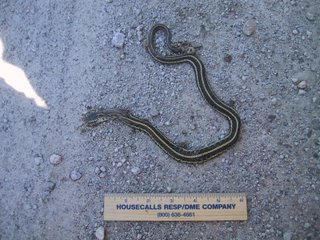Now, if anyone is reading this in any state from Indiana to Montana to Kansas, inclusive, and has a knowledge of local snakes, you're probably thinking "Plains garter? Endangered? We've got tons of 'em!" Yes. Yes you do. But if you'll look at the range posted on ODNR's website about them, you'll see a tiny dot in northwestern central Ohio. That is Killdeer Plains Wildlife Area, where I spent much of my high school career.
Visually, the plains garter is nothing too impressive. It gets to be at most 2 feet long, which you can compare to the harmless black rat snake at 6 feet. In terms of coloration, I was hard pressed to tell it from the common eastern garter snake. The difference consists of a row of dots under the lateral stripes on the plains garter. It is even behaviorally unobtrusive, as it manages to be less likely to bite than the common garter snake, which I have picked up dozens of times without getting bitten. Its preferred habitat is, of course, plains and praries, but more specifically, near the ponds and drainage areas to be found in such habitat. Food sources for the plains garter include large insects and small rodents (agricultural pests, if anyone's wondering why we should save these snakes), along with amphibians and earthworms.
A threat facing many endangered species, habitat loss, is what has endangered the plains garter snake in Ohio. We're already at the eastern edge of its range, and the conversion of more and more prairies into developed land, agricultural fields, or even forests, has led to fewer numbers of plains garters.
Another issue plaguing these snakes is traffic, which is how I became came to know of the plight of this species. As a freshman in high school, I wanted a science fair project where I could do research on wildlife. I managed to get in touch with the contract herpetologist with ODNR, and he suggested that I perform a road mortality survey at Killdeer Plains Wildlife Area. Consequently, for the next four years, my fall season was spent by peeling dead snakes off the road. A few unfortunate specimens were the plains garter. This is why many of the pictures I have of them look like this:
 |
| Image by me |
 |
| Image also by me |
A short note on biodiversity:
I have mentioned that plains garter snakes look a great deal like common garter snakes. They also both live in similar areas. They eat about the same thing (earthworms, small rodents, frogs), but a study in the late '70's showed that there were plenty of those to go around, so there's no competition for food. "Hey," says the contrarian, "why do we need two of these, if they fill the same niche? Why do we need to save the one, if there's another just like it?" Well, they aren't exactly alike. There are habitat differences (the common garter snake is a habitat generalist), along with many genetic differences that don't show up in ecological research. What happens when a disease comes by and takes out a large number of common garter snakes, but the plains garter is immune? You'll be glad it's there, helping keep the rodent and insect population in check.

2 comments:
fascinating, especially if your a person that went on one of these trips to see this great event of finding, snakes on the road (maybe a new movie?) Anywho..is that second pic a dead snake? He looks like he's just slithering, or whatever you scientifically call it. Can't wait for more fun information on ugly things. woohoo!
-Shelley
Nope, the second one's alive. It's the one I had to use for ISEF, since their rules wouldn't allow photographs of dead animals... But those are the COLORFUL ones!
Post a Comment